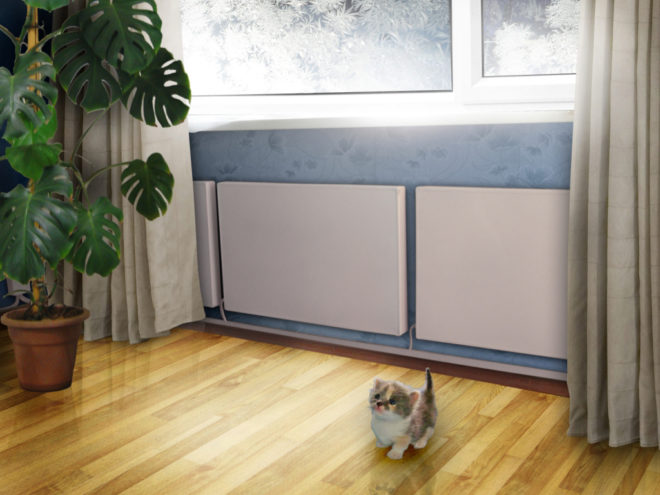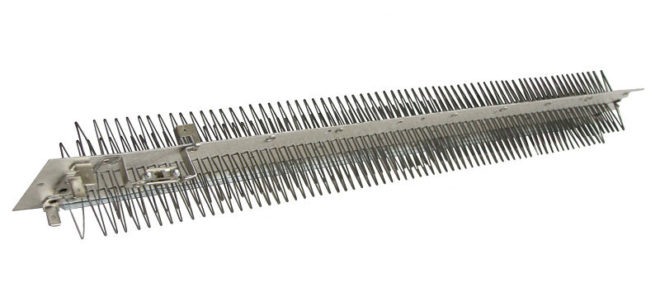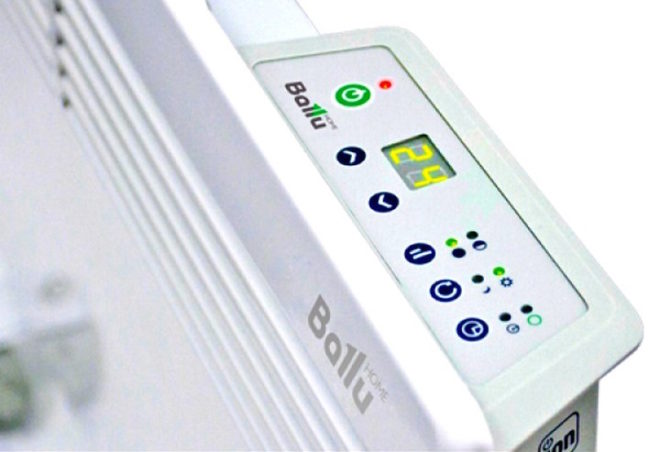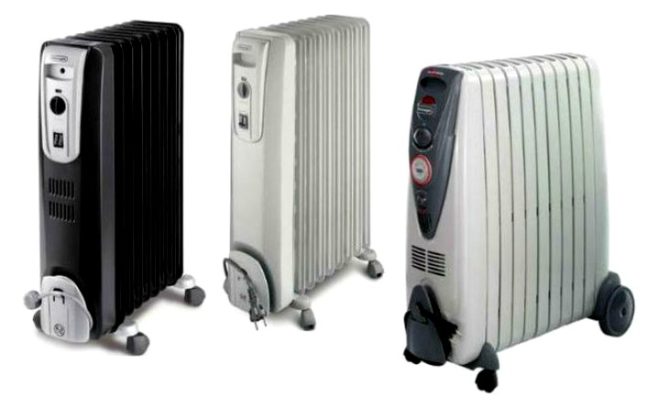Economical electric heaters - myth or reality?

Home comfort and a comfortable temperature are two things, especially when it's winter outside. Living in an apartment where the temperature does not even reach 18 ° C, while outside the window, thirty-degree frost is a small pleasure. Today it is not difficult to solve this problem, since there are a large assortment of heating devices in stores. Naturally, the common man is not interested in bulky boilers, but in household devices for heating premises. Energy-saving heaters are very popular nowadays, since electricity tariffs are quite high, and few people want to overpay for comfort. In this article, we will deal with such devices in detail, and find out which heaters are better to buy so as not to get cold and at the same time not to overpay for electricity.
Portable electric heaters are sometimes used as the main heating devices, but this is quite rare. Much more often they play the role of auxiliary heat sources - for example, when the heating season has not yet begun, and the house is already cold.

It is generally accepted that these devices are very "gluttonous" in terms of energy consumption, which is why the sellers deftly use the words "energy-saving electric heaters", thereby attracting customers. However, this is nothing more than a marketing ploy. The time when electric heating devices really consumed a lot of energy are gone. The use of modern technologies has led to the fact that almost any modern electrical appliance for space heating can be called energy-saving.
Content
The principle of operation of modern electric heaters
All of these devices are designed to solve the same problem, but they do not work according to the same principle. There are three main ways in which heat transfer is carried out:
- Natural convection method. It is based on mixing air masses. Cold air is denser and heavier than warm air, so it sinks down, giving way to the last one that rises up. Most convection appliances are characterized by a radiator design.

- Long-wavelength radiation method. Devices operating on the principle of long-wave radiation (for example, infrared electric heaters) heat the walls and ceiling of the room, as well as the objects in it. Air is heated by means of warm surfaces.

- Heat-ventilation method. Fan heaters and heat guns work according to this principle. These devices include a heater and a fan. The heating element raises the temperature of the air passing through it, and then the heat flow is discharged into the room by a fan.

Combined devices that can be found in specialized retail outlets are not uncommon. They are convection heaters equipped with fans.
Varieties of heating elements

Modern heaters are tape-needle, monolithic, and also equipped with a protective casing. Let's dwell on them in more detail.
- Ribbon-needle. Devices of this type are distinguished by their simplicity of design and low cost, but they have significant disadvantages. These include the absence of thermal inertia in these devices and high power consumption.In addition, they are very poorly protected from moisture; therefore, they are not recommended to be installed in rooms with high humidity and the possibility of vaporization.
- Equipped with a protective cover. These elements have external ribs, most often made of aluminum, and are well protected from external influences. The casing is filled with insulating materials with high thermal conductivity (ceramics, quartz, magnesium). The ribs of the heaters can have different shapes, their number can also be different - it depends on the price of the electric heater and the tasks it faces. These are truly energy-saving heaters, in addition, they are moisture resistant and can even be installed in bathrooms. The disadvantage of these devices is that they crack over time, since steel and aluminum have different coefficients of expansion - because of this, the efficiency of the devices decreases.
- Monolithic heaters. These heaters have the highest cost, but at the same time they are characterized by maximum efficiency and low energy consumption. Inside the case, the plates of which are made of an aluminum alloy, dielectric substances are contained. Such heaters are much more durable than all others and are quiet during operation. The cost of purchasing them will pay off over time by saving electricity.
As you can see, electric heaters with a monolithic element are the best option, but if its price is too high for you, you can opt for a device with a protective casing.

Modern electric heaters can be equipped with the following types of control mechanisms:
- Mechanical.
- Electronic.
- Mixed (electronic-mechanical).
Now let's move on to a detailed review of popular energy-saving devices for heating rooms, which are currently common and differ from each other in structure, as well as in the principle of operation.
Oil-fired electric heaters

These heating units are currently the most popular. They are based on a metal housing containing mineral oil. A heating element is also mounted there. It heats the liquid, which then transfers heat to the body, from contact with which the surrounding air heats up.
The power of these devices can range from 1 to 2.5 kW. They include a temperature setting relay and a temperature sensor. When the temperature reaches the user-set level, a power outage occurs. When the temperature drops, the relay automatically resumes power supply.
The temperature of the body of the oil heater during operation does not exceed 60 ° C, so there is no danger of burns when touching it. The disadvantage of the device is its rather large size. In addition, it will take a very long time for the heat to spread throughout the house.
The choice of oil heaters is described in this video:
Electric heaters of convector type
These devices are small and flat. They work according to the following principle.
There are several slots in the upper and lower parts of the heater body. A heating element is mounted in the cavity of the apparatus from below. Cold air enters through the lower slots, after which its temperature rises from contact with the heater. The heated air flow rises upward, leaving the room through the upper slots.

There are the following types of electric convectors:
- Panel wall stationary modification.
- Panel mobile.
- Skirting.
- Concealed (installed under the floor covering).
Often, modern convector heaters are equipped with thermostat blocks or technological temperature regulators.These mechanisms ensure the maintenance of the room temperature at the level set by the user, thanks to the latest sensors included in their functional diagrams. On many devices, they are installed at the bottom of the case and are visible to the naked eye.
For the selection of convectors, see here:
Infrared electric heaters
Most people consider the following characteristics to be the main requirements for an ideal electric heater:
- Proximity to natural heat sources.
- Low power consumption.
- Efficiency.
- The ability to maintain a comfortable indoor temperature.

Energy-saving ceiling infrared panels that meet all these requirements are widely used. Such devices may well serve as the main source of heating for a country house or other room with an area of up to 12 sq. meters. If the area is larger, then they can be used as additional heaters. These devices are harmless to humans and can be operated even in the presence of small children. Infrared panels are inertialess and begin to generate heat immediately after switching on. Among infrared heaters, the best are the devices equipped with carbon lamps.
Such devices are very economical, safe and versatile, they are easy to install and use. Their only drawback is their high price - they cost much more than convection or oil appliances.
Quartz electric heaters

Quartz heaters are gaining popularity slowly but surely. Outwardly, they are a monolith slab, for the manufacture of which a solution containing quartz sand is used. The device is powered by household power. The heating element made of nichrome has good insulation, which prevents it from coming into contact with the environment.
An electric quartz heater is indispensable if you need to maintain the temperature in a country house that you visit only on weekends. It is enough to set the regulator to 10-15 ° C before leaving the cottage and leave the device plugged in. Quartz devices are fireproof, they do not heat up to more than 95 ° C and do not close, therefore they never cause a fire.
How quartz heaters work, see this video:
Ceramic electric heaters
These panels combine excellent thermal convection ability with gentle infrared rays. Their main difference from IR panels is the ability to quickly warm up not a separate zone, but the entire interior space of the room due to the hybrid principle of operation. Electric heaters made of ceramics, being installed in an apartment or a private house, make it possible to do without boiler room equipment and installation of heating systems.

The main advantages of ceramic panels include:
- High efficiency.
- Waterproof.
- No harm to human health.
- Explosion and fire safety.
The ceramic panels work in automatic mode, which allows them to maintain the temperature throughout the room at the desired level.
Conclusion
Many people, remembering what heaters were like a few years ago, still cannot believe that modern electric heating devices are not only efficient and safe, but also economical. However, this is a fact. It is worth remembering that IR panels were used in children's clinics in the Soviet Union. You can determine the low consumption of electricity even by the readings of your home meter. In addition, the efficiency of the devices can be increased by conducting high-quality preparation and minimizing heat loss.
This article describes in detail the principles of operation of modern electric heaters, their advantages and disadvantages. You just have to make your choice.It is worth remembering that although modern heaters are not cheap, the money spent on their purchase pays off quickly enough due to low electricity consumption.
